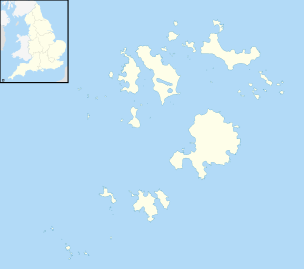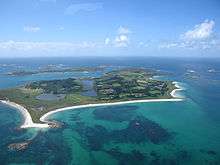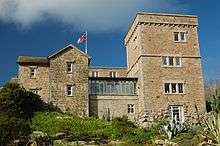Tresco, Isles of Scilly
| Tresco | |
| Cornish: Enys Skaw | |
 Tresco seen from Bryher |
|
 Tresco |
|
| Population | 175 (2011) |
|---|---|
| OS grid reference | SV893421 |
| Civil parish | Tresco |
| Unitary authority | Isles of Scilly |
| Ceremonial county | Cornwall |
| Region | South West |
| Country | England |
| Sovereign state | United Kingdom |
| Post town | ISLES OF SCILLY |
| Postcode district | TR24 |
| Dialling code | 01720 |
| Police | Devon and Cornwall |
| Fire | Isles of Scilly |
| Ambulance | South Western |
| EU Parliament | South West England |
| UK Parliament | St Ives |
Coordinates: 49°57′22″N 6°19′55″W / 49.956°N 6.332°W
Tresco (Cornish: Enys Skaw,[1] meaning "island of elder-trees") is the second-biggest island of the Isles of Scilly in Cornwall, England. It is 297 hectares (1.15 sq mi) in size, measuring about 3.5 kilometres (2.2 mi) by 1.75 kilometres (1.09 mi).
History
In early times one group of islands was in the possession of a confederacy of hermits. King Henry I gave it to Tavistock Abbey which established a priory on Tresco; it was abolished during the Dissolution of the Monasteries. The priory was given the care of souls in the secular islands by the lord of the fief.[2] In 1233, a prior here, known as Alan of Cornwall, was made abbot of Tavistock.[3]
The original name for the island (including Bryher) was the Cornish: Ryn Tewyn meaning promontory of sand-dunes. In 1193 when the island was granted to the abbot of Tavistock by Pope Celestine III the island was known as St. Nicholas's island and by 1305 it is called Trescau (farm of elder-trees). By 1540 this has changed to Iniscaw (island of elder-trees).[4] The island was named as Trescaw in an 1814 publication.[5]
The island is administered for the crown by the Duchy of Cornwall[6] and is leased to the Dorrien-Smith estate, which runs it as a timeshare business. The Dorrien-Smith family (descended from Augustus Smith) held the position of Lord Proprietors of the Scilly Islands between 1834 and 1920.
From 2001 until 2009, the island hosted a marathon run organised in aid of Cystic Fibrosis. The course consists of 7½ laps around the island. The event is always held on the same day as the London Marathon.[7] Past winners include Dara O'Kearney and Bob Brown.
In 2007 a rebuild of the Abbey Farm/Shed area was completed; this area served as RNAS Tresco, a seaplane base during the First World War.[8] The development included rental cottages, a swimming pool, a health centre and the "Flying Boat Club" restaurant.
Geography

A variety of scenery is found on the island, including rugged granite outcrops, heathland of the exposed north coast and mainly shell beaches in the east and south. The variety of its scenery and geomorphology is partly a result of the last ice age, where the Devensian ice sheet clipped the north side of the island leaving deformation till deposits.[9][10]
The main settlements are New Grimsby and Old Grimsby in the central part of the island. Combined, their facilities include a convenience store (with a post office sub-branch), an art gallery, a pub, and two café/restaurants, all of which are owned and run by the Tresco Estate. At the south of the island can be found the sub-tropical Tresco Abbey Gardens, including the Valhalla Figurehead Collection, and Tresco Heliport. To the north of New Grimsby are King Charles's Castle and Cromwell's Castle.
Civil parish and ward

Tresco is one of the five civil parishes of the Isles of Scilly, which are also wards. The civil parish and ward covers much more than the island of Tresco; it includes uninhabited islands such as Samson (inhabited until 1855), Teän, St Helen’s, Northwethel and Round Island.[11] Tresco returns 2 councillors to the Council of the Isles of Scilly, the same as the other "off-island" wards. The civil parish is not functional however, and there is no council or meeting.
Demography
These figures constitute permanent residents only. A large number of seasonal staff also reside on the island during the summer period.
|
|
|
Economy
The character of Tresco varies from that of the other islands in the Scilly archipelago as it is primarily run as a holiday resort,[12] with virtually all activity and employment being tourist-related. This contrasts with the other islands where tourism is important, but does not dominate to the same extent.
Landmarks




- English Civil War
- King Charles's Castle dates from 1550–54, and was occupied by the Royalists during the English Civil War. It was later partially demolished to provide the building materials for Cromwell's Castle.
- A coastal tower known as Cromwell's Castle, was built 1651–52 with gun platform added ca. 1740 by Abraham Tovey, Master Gunner.
- The Old Blockhouse gun tower protecting Old Grimsby harbour, vigorously defended during the Civil War. It was probably built between 1548 and 1552.
- Oliver's Battery, in the south of the island, by the Carn Near quay, erected shortly after the capture of Tresco by Parliamentary forces in the English Civil War. It was built by Admiral Robert Blake.
- Other landmarks
- Monument to Augustus Smith above Appletree Bay on the south west of the island.
- Arch from the wall of the mediaeval monastery in Tresco Abbey Gardens.
- Anglican church, see St. Nicholas' Church, Tresco.
Transport
Tresco is a car-free island. Farm tractors with passenger trailers are used to transport overnight visitors to and from Tresco Heliport and from the various quays, and a few golf carts are available for disabled visitors.
From 1983 to October 2012 British International Helicopters operated from Tresco Heliport, providing a year-round helicopter service to Penzance Heliport.
Tresco Boat Services (formerly Bryher Boats) run passenger boat services to and from the other inhabited islands, as well as occasional circular sightseeing tours.
Wildlife and ecology
Tresco is unique amongst the off islands in that its habitat ranges from a windswept northern plateau with waved heath to sheltered bulb fields, wetland and lakes, to beautiful beaches backed by a sand dune system on the south coast.[13] Subsequently, the forerunner of Natural England designated three Sites of Special Scientific Interest (SSSI) in 1971 and 1976. They are the Castle Down (Tresco) SSSI, Great Pool (Tresco) SSSI and Pentle Bay, Merrick and Round Islands SSSI. Castle Down is a SSSI for it waved maritime heath, its lichen flora, a breeding colony of Common Tern (Sterna hirundo) and for its geology. Great Pool is a SSSI because it is the largest area of fresh water in the islands and important for its breeding birds, and as a sheltering and feeding area for migrants. Pentle Bay is designated for the transition from a flora–rich sand dune system to lichen–rich heath.[14] [15] [16]
In October 2012, four male and one female Red Squirrel (Sciurus vulgaris), on permanent loan from the British Wildlife Centre, was transported to Tresco by helicopter. Only two survived and in September 2013 a further twenty were transported to Tresco and released in Abbey Woods, near the Abbey Gardens. Tresco is considered to be a ″safe haven″ for the endangered mammal as it is free from predators such as foxes, and is free from Grey Squirrel and the squirrel pox they carry.[17][18] In June 2014, an unknown number of baby squirrels have been pictured in the Abbey Gardens, proving the squirrels are successfully breeding.
Vagrant birds
Among the many vagrant birds which have been found here, the following were firsts for Britain:
- Common Nighthawk (Chordeiles minor) collected on 17 September 1927.
- Western Sandpiper (Calidris mauri) originally identified as a Semipalmated Sandpiper, 1969.
Cultural references
Because of its geography and history, Tresco has often featured in fiction. Most notably in the books of author Sam Llewellyn, a direct descendant of Augustus Smith who, after his appointment as Lord Proprietor of the Scillies in 1834 and living on the island, began to create the Abbey Gardens on land which surrounded the old Priory.
- Flora Castledine, lead character of the Georgie Gale novel Tread Softly, was born and brought up on the Isles of Scilly. Tresco is mentioned several times.
- Why the Whales Came by Michael Morpurgo is set in the Isles of Scilly and features Tresco several times.
- Hell Bay, by Sam Llewellyn, is set on Tresco and fictionalises the events leading up to Augustus Smith taking ownership of the island.
- The Sea Garden, also by Sam Llewellyn, is set on a fictional island based heavily on Tresco. It features a stunning Sea Garden much like the Tresco Abbey Gardens and the history of the fictional island draws heavily from the real history of the island.
- Storm Islands, by Ann Quinton, is a mystery novel set on Tresco and in the Isles of Scilly.
Filmography
- In the 1989 BBC adaptation of The Voyage of the Dawn Treader, the scenes on the fictional Lone Islands were filmed on Tresco, with the on-ship scenes being filmed on a ship on the surrounding sea.
- Tresco is the setting for the 2010 film Archipelago, directed by Joanna Hogg and starring Tom Hiddleston. It premiered at the 2010 London Film Festival, and was released on 4 March 2011 in the U.K. and Ireland.
- In the early 1980s Tresco was used by the group Blondie for the location of filming the video to the song "Island of Lost Souls".
See also
References
- ↑ Place-names in the Standard Written Form (SWF) : List of place-names agreed by the MAGA Signage Panel. Cornish Language Partnership.
- ↑ Blackford, Oscar (1925). Cornish Church Guide. Truro: Blackford. p. 194. ASIN B00T7TMMMO.
- ↑ Alford, Rev. D. P. (1891). The Abbots of Tavistock with Views Beyond. Plymouth: W. Brendon & Son. p. 123.
- ↑ Weatherhill, Craig (2005). Place Names in Cornwall and Scilly. Wessex Books. ISBN 1903035252.
- ↑ 'The Scilly Islands', Magna Britannia: volume 3: Cornwall. 1814. pp. 330–337. Retrieved 14 November 2009.
- ↑ Gill, Crispin, ed. (1987). The Duchy of Cornwall (1st ed.). David & Charles. ISBN 0715388916.
- ↑ "Tresco Marathon". Tresco Estate. Archived from the original on 26 April 2009. Retrieved 20 October 2016.
- ↑ Lewis, Peter (1968). Squadron Histories: R.F.C., R.N.A.S. and R.A.F., since 1912. Bodley Head. p. 82. ISBN 0370000226.
- ↑ Deformation tills are sediments which have been disaggregated and (usually) homogenised by shearing in the sub-glacial deformed layer.
- ↑ Van der Meer, J., et al. (2003) "Subglacial Till: the deforming glacier bed", in: Quaternary Science Reviews; Vol. 22, pp. 1659–85
- ↑ Ordnance Survey 1:25,000 map
- ↑ "Tresco Island, Luxury Cottages, Holiday Island Resort, Isles Of Scilly | Tresco Island". Tresco.co.uk. Retrieved 2016-10-20.
- ↑ Cooper, Andrew (2006). Secret Nature of the Isles of Scilly. Dartington: Green Books. ISBN 9781903998519.
- ↑ "Castle Down (Tresco)" (PDF). Natural England. Retrieved 25 November 2012.
- ↑ "Great Pool (Tresco)" (PDF). Natural England. Retrieved 25 November 2012.
- ↑ "Pentle Bay, Merrick And Round Islands" (PDF). Natural England. Retrieved 8 April 2012.
- ↑ Mumford, Clive (1 November 2012). "Squirrels to be released in 2013". The Cornishman. p. 16. Retrieved 14 November 2012.
- ↑ "RNAS Culdrose helicopter flies red squirrels to Tresco". BBC. Retrieved 5 November 2013.
External links
| Wikimedia Commons has media related to Tresco. |
- An illustrated history of Tresco from the Bronze Age to the present 'The Last Piece of England'

